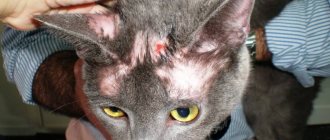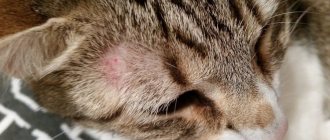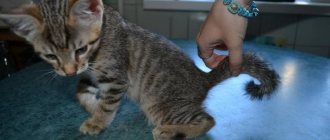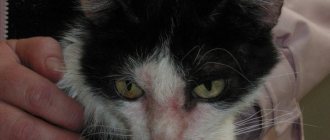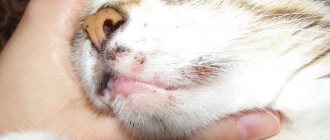Symptoms
Weeping eczema in cats is a disease that affects the epidermal layer without affecting the dermis itself.
Eczema is characterized by stages of development. The disease can occur in acute, subacute or chronic form. If eczema becomes chronic, most often it stops at one stage and stays there for a long time.
The acute form of weeping eczema, also called erytomatous, is characterized by the occurrence of changes on the skin in the form of hyperpigmentation of tissue structures and the formation of specific seals protruding above the surface. The development of the acute stage is characterized by the appearance of the following symptoms:
- increased body temperature;
- an increase in the size of the red spot;
- the appearance of uncomfortable, itchy sensations;
- there is no pain in the hyperemic area.
After a few days, the initial stage of eczema smoothly passes into the second. The papular form is characterized by the appearance of specific nodules on the reddened area, dense when palpated, resembling small poppy seeds. As soon as the grains merge into one, a vesicular form is formed. Vesicles are represented by peas filled with light-colored exudate.
The vesicular stage may have several scenarios. In the first case, the bubbles that appear and the liquid formed in them dissolve on their own, and the tissue structures dry out. The upper cells of the epidermis (corneocytes) exfoliate, and the skin becomes healthy in appearance.
In the second variant of the vesicular stage of eczema in a cat, the peas are opened under the pressure of the liquid inside. The cause of vesicle rupture may be mechanical scratching. Pathogenic bacterial microflora penetrates into exposed, unprotected areas. As a result, ulcers develop. Constant scratching, the appearance of new pustules, drying out of the top layer, leads to the fact that the skin acquires a purple tint and looks swollen. Ulcerative lesions appear on the skin of a cat affected by eczema. This stage is called pustular in medicine.
It is during this period that eczema is called weeping. At the site of development of the pathological process, there is a disturbance in hair growth. Areas of alopecia appear, as well as areas of fur stuck together from exudate.
Erosion on the skin in the form of weeping wounds in the absence of additional moisture gradually begins to crust over and dry out. Exudative processes are gradually decreasing. The fresh crusts that appear begin to darken, narrow and fall off. Hyperemia and swelling go away on their own after the crust falls off. There will be healthy, undamaged skin underneath.
In the absence of timely assistance, the acute and subacute stages of eczema become chronic, which is difficult to treat. The veterinarian's prognosis is cautious, closer to unfavorable.
In case of increased secretion of purulent exudate, the affected areas are completely covered with pus. The ulcerations become wider and go deeper into the skin. Cellulitis often develops; the process involves soft tissue structures located under the skin.
Diffuse purulent inflammation extends not only to the area of subcutaneous tissue, but also affects muscle fibers along with tendons. In some cases, with chronic eczema, the internal organs of the animal are affected.
Diagnostic measures
If an owner suspects wet eczema in a pet, it is important to visit a veterinary clinic with the kitten as soon as possible. At the appointment, the doctor will conduct a survey and find out how long ago the cat’s weeping wound was noticed. Mostly, a primary examination is enough for a doctor to make a diagnosis. However, it is also necessary to identify the factor that caused the disease.
For these purposes, the animal is first sent for skin scrapings, which make it possible to identify the possible presence of other dermatological diseases. For example, psoriasis is often diagnosed in cats. If the veterinarian suspects an infectious lesion of the epidermis, a bacteriological culture is performed. Additionally, the animal is prescribed a general examination of urine and blood, as well as allergy tests. In exceptional situations, a biopsy of tissue that has been affected by the disease is prescribed.
Causes
The following factors contribute to the occurrence of eczema:
- Traumatic.
- Neuropathic.
- Reflex.
- Interior.
Traumatic eczema
It occurs as a result of damage from accessories rubbing the skin, arthropod bites, frostbite, burns, and trauma from the claws of the cats themselves. The disease occurs in a weeping form and quickly stops after its cause is eliminated.
Neuropathic eczema
It is the result of stress or a congenital anomaly. This type of eczema is characterized by symmetrical bilateral skin lesions. It occurs in dry and wet form. The disease is characterized by remissions and exacerbations under the influence of stress factors.
Reflex eczema
It is a hypersensitive response to a stimulus. The reaction occurs under the influence of the following allergens:
- Arthropod saliva.
- Household items.
- Food allergens.
- Atopic dermatitis.
- Dust.
- Accessories.
Internal factors
Internal causes of eczema are associated with organ pathologies, irrational feeding, and hormonal perversions. Signs of the disease disappear when the factor that caused them is eliminated.
Treatment
In cats, treatment can be quite lengthy, the prognosis depends on the cause of the disease, for example, the neuropathic form is less treatable than others. In any case, a preliminary consultation with a specialist is required, a series of examinations that will help to describe the treatment regimen as accurately as possible.
The principles of therapy for dermatosis in cats are similar to therapy for humans, the same means are used. If it worsens, the veterinarian will prescribe injections; to treat the affected areas, the hair around them should be carefully trimmed.
The following drugs and groups of drugs are used for therapy:
For dry eczema, moisturizers are used to help soften the affected area and prevent peeling and cracking. For cats, it is recommended to use Vaseline, baby creams without fragrances and fragrances. To disinfect affected skin, antiseptics should be used. They are applied before using basic products, most often potassium alum, tannin solution, formaldehyde. For weeping eczema, dust, bismuth salts, and rivanol will be effective. To have a drying effect, the usual brilliant green and iodine are prescribed; for disinsection of the affected area, ethyl alcohol and hydrogen peroxide are prescribed. External treatment often requires the use of hormonal ointments. Steroids are prescribed for complications; they not only speed up recovery, but also alleviate the general condition of the pet
But hormonal medications for cats should be used with great caution to prevent side effects. Among the most effective remedies are Triderm, Advantan, and hydrocortisone ointments. Non-hormonal creams are used for topical treatment after taking corticosteroids
The drugs are taken for a month until remission occurs. Among the most effective are Radevit, Pikhtoin, Saphroderm and others. Antibiotics are used as part of antimycotic and antibacterial therapy for cats, but only a veterinarian can prescribe a specific drug after examination. The most suitable powders for pets are Tsamax, Ranosan, Anandin, tetracycline ointment, Vedinol and others.
To speed up a cat’s recovery, vitamin complexes and medications are often prescribed to strengthen the immune system and improve skin regeneration. Weeping eczema is the most difficult to treat, requiring additional action. Usually, doctors, along with traditional therapeutic methods, prescribe a number of folk remedies that help cope with the disease and significantly alleviate the animal’s condition.
Traditional methods of treatment
Eczema in cats can be treated using traditional methods, but only after consultation with a veterinarian. There are many methods, but all of them are external and are recommended as an addition to the main therapy.
The following recipes are recommended for pets:
- Decoctions from willow bark. Making such a remedy is very simple, you need to brew two tablespoons of bark in a glass of water (about 10 minutes), then cool the solution and wash the wounds with it several times a day.
- Tinctures of dandelion and burdock roots. To do this, you can use dried or fresh ingredients; they are infused in 0.5 liters. vodka in an amount of 2 full tablespoons of each component. Preparation time: 10 days; infuse in a dark place. The resulting tincture is applied to areas of skin damage in the evening and in the morning, treatment time is a week. The tincture relieves itching, relieves discomfort and other symptoms.
- An infusion of fresh currant leaves is well suited for washing wounds. A handful of leaves should be brewed in two glasses of boiling water, left for an hour, then cooled and used for procedures.
- For dry eczema, a compress based on regular sunflower oil and celery works well. The crushed root must be mixed with oil (only unrefined oil is suitable), after which the resulting product is used for compresses. This remedy removes itching, swelling, and alleviates the pet’s condition. Compresses can also be made at the stage when bubbles appear.
- Ointment based on celandine. Only a fresh plant is used for preparation; the ointment can be stored in the refrigerator for about a year. For preparation, a gruel of crushed celandine and petroleum jelly is used in a ratio of 1:4. The product should be applied 2-3 times a day, treating the affected areas.
Eczema is a disease caused by poor nutrition, emotional discomfort, and poor pet hygiene.
It is very important to immediately contact a veterinarian at the first signs of illness, as complications will be much more difficult to get rid of.
How to relieve the condition of our beloved furbabies
It is worth noting that treatment of weeping eczema in cats should only be carried out under the supervision of a qualified specialist. Communication with the audience: It is at this point in our story that we want to warn you against rash actions.
Has your cat recently begun to lose hair, and underneath it appear weeping, rotting areas of skin? Our advice!
Go to the vet immediately! Do not treat the animal yourself!
This can lead to unpredictable consequences! The treatment process should be directed and controlled only by a doctor!
To prescribe adequate treatment, the veterinarian must take into account the condition of the animal, the severity of the disease, and visual symptoms. To confirm his version, he may additionally order a scraping from the affected area to examine its material.
Before starting the main treatment, it is necessary to eliminate all possible causes of the symptoms of the disease and its predisposing factors. In this case, it is very important to adjust the animal’s diet by including plant foods with fermented milk products in its diet. During the treatment period, it is better to stop feeding the cat:
- Canned food;
- Fatty meat.
Typically, veterinarians provide medical care with traditional patented drugs. Initially, the animal is prepared for local treatment by first cutting off its hair in the affected area and disinfecting the area with alcohol or ordinary hydrogen peroxide.
At the same time, the main group of pharmacological drugs includes:
- Ointments with a moisturizing or astringent effect;
- Antiseptics that destroy pathogenic microorganisms;
- Complex of vitamins and minerals;
- Immunomodulators;
- Antibiotics for maintenance therapy.
[custom_ads_shortcode1]
Dangerous skin diseases of cats
Caused by internal pathologies or quickly progress to the stage of exacerbation, life-threatening.
Demodicosis
Microscopic mites are very active. Poisoning from bites spreads so quickly and abundantly that many cases of death are known.
In a mild form, white pimples with pus, partial baldness, red crusts, scratching and a small rash are noticeable on the skin. Over a long period of time, the cat easily scratches the pustules until they become ulcers, introduces infections and bacteria, becomes very weak, and loses appetite.
Demodicosis in cats
Ostiofolliculitis
Ulcers are located in hair follicles. The hair bag becomes clogged with sebum, becomes inflamed, and a staphylococcal bacillus settles inside the bag. If the disease is not treated at the beginning, it quickly progresses into acute furunculosis and peptic ulcer.
It can be detected by redness around the roots of the hairs, purulent pimples up to the size of a pea, burst blisters with crusts on top. The cat becomes restless and does not allow itself to be petted, as touching causes pain.
Ostiofolliculitis
Abscesses
Inflammation in the form of a soft cyst or lump on the skin. There is a lot of purulent exudate inside it. It starts to smell after it bursts and the liquid leaks onto the skin. The smell is especially pungent and unpleasant. Large abscesses greatly impair immunity. The cat may contract an infection during treatment. Therapy is also not fast. Drains are placed in the burst wound to remove all remaining fluid. We have to use strong antibiotics.
Abscesses on a cat's neck
Malasseziosis
Fungal infection. One of the most difficult to treat skin diseases in cats. Diagnosis is difficult and the course is protracted. Treatment requires heavy drugs that harm the rest of the body.
The characteristic smell gives off mold, spoiled cheese or milk. In the groin, near the back opening, behind the ears, near the mouth, claws and nose, you can find redness, rashes, moisture, and sores. The skin becomes painful, so the animal cannot be handled, hisses, and scratches. Relapses occur frequently and for a long time.
Malasseziasis is one of the most difficult to treat skin diseases in cats.
Ringworm
Pathology of an infectious fungal nature. Kittens and cats with oncology or weakened immunity after viruses are more often susceptible.
Fungal spores can be brought to your pet on street clothes or shoes. Spread occurs through household items and personal contact between animals.
The cat is actively losing hair on its head, limbs and tail. The skin in exposed areas peels, itches, becomes very red and pink. In these areas, pustules and crusts appear, which are easily scratched off with claws to open wounds. The disease can gain momentum for up to 2 years. With this course, the pet quickly weakens, loses weight, stops eating and may die from exhaustion. During this period, it is easiest to become infected with fatal infections, since the body does not have the strength to resist viruses. In severe cases, the ulcers spread to the paw pads and it becomes difficult to move.
Ringworm
Treatment without the participation of a doctor is impossible.
Atopic dermatitis
Chronic allergic reaction of the skin to irritants. The body reacts to dust, mold, pollen, household chemicals, and food with severe itching, rashes, hair loss, and ulcers. The cat will scratch especially a lot on the head, ears, chest, neck, lower abdomen and thighs. Dermatitis is severe and weakens the animal. Ulcers are constant and profuse. It is difficult to select living conditions and food for the safe living of a pet.
Atopic dermatitis is a chronic allergic reaction of the skin to irritants
Cushing's syndrome
A rare hormonal disease, a reaction to too high levels of cortisol in the blood. Side effect of pituitary disease, adrenal tumors, injections and oral corticosteroids.
The cat suffers from thinning skin, acne with a small amount of pus. It scratches them off, which can result in difficult-to-heal wounds. The disease causes gluttony, a swollen abdomen, constant thirst, frequent urination, lethargy, muscle weakness, and hair loss.
Treatment is long and difficult. A severe metabolic disorder in the body may occur, leading to exhaustion and diabetes.
Cushing's syndrome is a rare hormonal disease, a reaction to too high levels of cortisol in the blood.
Allergic skin diseases
Many breeders associate the word “allergy” with a runny nose, watery eyes and other minor troubles. This is partly true, but allergic reactions in practice are much more dangerous. In particular, they are considered the main cause of incurable and deadly diseases, but even in “moderate” cases of pathology, these pathologies can cause a lot of trouble.
Allergic dermatitis
Dermatitis is a pathology accompanied by inflammation of the skin. Accordingly, in this case, the inflammation is caused by a serious allergic reaction.
Firstly, the latter leads to a catastrophic weakening of the skin’s protective mechanisms, which is why it can no longer resist the action of pathogenic and conditionally pathogenic microflora.
Secondly, a much worse option is possible: due to increased vascular permeability, lymphocytes begin to migrate en masse into the thickness of the epithelium. This effect is called lymphocytic or neutrophil infiltration and, by the way, it often leads to the development of autoimmune inflammation. Stress factors accelerate and intensify the pathological process.
Symptoms of allergic dermatitis in cats
Unlike “simple” inflammations, the symptoms of which develop over a long period of time, allergies are lightning fast. Just yesterday, your cat could just be itching, and by morning, large areas of her skin would become inflamed. It becomes swollen, turns red, and acquires a slightly “watery” consistency of dense jelly.
Another sign of the allergic nature of the disease is always itching. It is so strong and exhausting that the cat can tear off shreds of skin by scratching it furiously. All this leads not only to the formation of many scratches and even wounds on the skin, but also to its purulent inflammation (due to the ubiquitous pathogenic microflora).
Treatment
First, it is necessary to stop the allergic reaction, which is quite enough to treat mild and unadvanced cases.
The animal is prescribed loading doses of antihistamines (which include the widely used Diphenhydramine).
To prevent the development of secondary bacterial infections, broad-spectrum antibiotics are prescribed.
To eliminate diffuse areas of inflammation, anti-inflammatory corticosteroids are needed. Their advantage is that they significantly reduce the risk of developing autoimmune pathologies. The most common and effective medication is prednisolone. Its average dose is 0.1 mg per kilogram of live weight (once a day).
Often these drugs have to be used for a long time, several weeks. To shorten the treatment period, it is much more practical to simultaneously administer dexamethasone. This remedy allows you to reduce the dose of corticosteroids and reduce the period of their use.
Milliary dermatitis
One of the varieties of the previous pathology. However, this disease has specific features that make it possible to distinguish it into a separate subsection.
Symptoms
The disease also begins with severe itching and swelling, but edematous phenomena are rare, and instead of them numerous nodular rashes appear on the skin. Hair falls out en masse on the affected areas of the body, and the pet’s resting places are simply littered with it.
Treatment is similar to that for ordinary allergic dermatitis.
Allergic eczema
In many ways, this disease is similar to the previous one, but still it differs in a number of specific aspects, which is why these pathologies should not be considered comprehensively.
Symptoms
- It all starts with an itch.
- Soon, slight redness appears on the skin of the sick animal.
- Red spots turn into ulcers and erosions. They are instantly contaminated with secondary bacterial microflora, resulting in purulent inflammation with itching.
- The inflamed areas are very painful, the sick cat’s condition quickly deteriorates, and he refuses to eat.
- The fur on the affected areas partially falls out and partially sticks together due to pus.
- The skin along the boundaries of healthy and inflamed areas macerates and swells.
Treatment
Similar to the treatment of allergic dermatitis. It differs only in large doses of corticosteroids, the mandatory prescription of large quantities of antihistamines (to quickly relieve itching) and dexamethasone.
Additionally, broad-spectrum antibiotics, without which it will not be possible to cope with bacterial inflammation.
Types of eczema in cats
Eczema in cats can take different forms, it all depends on the provoking factors, general living conditions, and nutrition. It is quite difficult to make a diagnosis on your own, so at the first symptoms of the disease you should consult a veterinarian. Only in this way will the cat be given the correct treatment with the necessary effectiveness.
Experts distinguish three forms of dermatosis in animals:
- Neuropathic eczema. Most often caused by disorders of the autonomic nervous system, the main causes are stress, genetic disorders, and some congenital diseases of the pet.
- Traumatic dermatosis. Most often it appears with skin irritations, damage to the epidermis, cracks, and abrasions. This phenomenon is usually observed in those cats that constantly wear tight collars. The traumatic form is diagnosed in unkempt animals, with poor personal hygiene, and with lesions from blood-sucking parasites.
- The reflex form can be provoked by various factors, including the presence of allergic reactions, numerous flea or tick bites, and pathologies of internal organs.
In addition, there are types of diseases such as dry and weeping eczema in cats. In the first case, cracks, peeling, swelling appear on the surface of the skin and severe itching is observed. The weeping form is characterized by the formation of blisters and wounds that cause serious suffering to the pet.
Question answer
A cat has eczema - can it be transmitted to humans?
No, the disease is not directly transmitted to humans. The exception is those moments when a person has skin lesions that were in direct contact with the purulent discharge of a cat’s weeping eczema. In such cases, complications of these injuries can sometimes occur. In all other cases, it is enough to simply wash your hands after contact with a sick animal and that’s it.
How to treat eczema in a cat?
Treatment should be carried out by a specialist, because The disease is complex and capricious. Cases have been recorded where the disease persists throughout her life, no matter what treatment was given. In any case, the general therapeutic course includes: antibiotics (orally and/or by injection), local treatments with ointments and creams with a complex effect (hormonal, antipruritic, antibacterial), surface rinsing with antiseptic solutions, intravenous drips, hepatoprotectors.
What is the difference between weeping eczema and dry eczema?
The names of the pathologies speak for themselves. A skin area with a moist surface in a cat without hair, moist, shiny, with ichor and sometimes with pus. Dry - has no signs of wetting, but has flaky areas with scratches, dried crusts, rashes, baldness, etc.
What are the main signs of eczema?
If you notice areas of redness, swelling, rashes or blisters with liquid contents, large weeping wounds, areas of baldness and flaky areas of skin that are hot, you can be sure that your pet is developing eczema. At the same time, in the veterinary clinic it is important to exclude ringworm and scabies (intradermal mites).
Is it possible to prevent eczema in cats?
Yes, it's quite possible. To do this you should:
- carry out regular treatments for worms and cutaneous and intradermal parasites;
- regularly inspect your pet’s skin, especially if you notice that the animal is licking or scratching itself a lot;
- feeding only those foods that do not or potentially will not cause an allergic reaction;
- timely replacement of collars and leashes for walks, do not wear them at all if the first signs of irritation are noticed;
- monitor your general health and promptly treat internal diseases;
- protect the animal from stress.
Symptoms and treatment of feline eczema
Regardless of the reasons for the appearance of inflammation in the upper layer of the epidermis, the signs of the disease are the same.
- The very first symptom is redness. This occurs as a result of the fact that it is in this area of the dermis that there is lymph and blood circulation.
- Itching. The place where the inflammation began is itchy, and the cat persistently tries to scratch it. Toxins accumulate in tissues, nerve endings are irritated - this is why itching occurs.
- If you touch a red area of skin, you can record an increased temperature in this spot. Sensitivity also increases.
- As a result of intoxication, bubbles appear. In the dry form, the blisters burst and the skin peels off; usually this form is characteristic of a chronic course. In the wet form, liquid leaks from the ruptured blisters, and the wound is constantly wet. This occurs due to infection of the inflamed area. Scratched wounds receive pyogenic microflora, which provokes wet, festering wounds.
Treatment
The diagnosis must be made by a specialist and treatment prescribed.
Primary measures:
- Isolate the cat from drafts and cold places.
- Treat against fleas, worms and free her from the collar (if she is wearing) during treatment.
- If eczema is a secondary disease against the background of inflammation of internal organs (this is also determined by a veterinarian), the underlying disease must be treated.
- Analyze your pet’s diet, eliminate potential allergens, and introduce vitamins.
- It is better to shave the affected area, this will avoid infection, and also treat it with alcohol or Chlorhexidine.
Treatment with drugs:
- To reduce a cat's irritability, bromine is recommended.
- To normalize skin sensitivity, sodium thiosulfate is needed.
- Antihistamines: Suprastin, Diphenhydramine.
- Methylprednisolone, Prednisolone and Dexamethasone are effective in treating eczema.
- Furosemide is needed as a diuretic to rid the body of toxins.
- Weeping eczema in cats requires treatment with Chlorhexidine, peroxide or Miramistin.
- To provide an astringent effect, a solution of tannin or silver nitrate is required.
- Zinc ointment is suitable for drying pappules.
- If a cat has dry eczema, Vishnevsky ointment helps.
Folk remedies are also appropriate in the treatment of eczema.
- Treatment of the affected area with chamomile decoction, calendula solution, oak decoction (has an astringent effect) is effective.
- St. John's wort oil removes dry eczema and accelerates cell regeneration.
- Aloe juice has a wound healing effect.
Disease prognosis
Eczema can occur in acute and chronic forms. Acute is typical for young cats, chronic - for cats over 6 years old, as well as for weakened pets.
The acute form can last about a month, and intensive treatment is effective in combating it.
How does the disease manifest itself?
Because of the fur of cats, the owner cannot always detect the symptoms of eczematous pathology in his pet. However, the unbearable itching of the animal can alert him. When examining the animal, you can notice inflamed, reddened skin at the site of scratching. Here she is tight and hot.
The situation is aggravated by the constant trauma of the claws to the inflamed area, the penetration of pathogenic bacteria into the scratches, the formation of small nodules and watery blistering rashes there. Next, these bubbles open, pyogenic contents infected with bacteria are released from them, which gives rise to weeping areas, erosion, ulcers, and rotting of the epidermis.
The main location of this disease in cats is observed in the area:
- Back to end of tail;
- Ear areas.
External and internal factors are involved in the development of disease symptoms in cats. External factors often include:
- Wool dirt;
- Constant friction;
- The influence of parasites;
- Using soap when bathing an animal;
- High or low temperatures;
- Microbial infection.
Internal factors that can cause weeping eczema in cats include:
- Weak immunity;
- Endocrine pathology;
- Ovarian dysfunction;
- Diseases of internal organs.
Depending on the reasons causing the development of the disease, veterinarians distinguish several types of weeping eczema in cats.
[custom_ads_shortcode3]
Prevention of skin diseases in cats
Prevention includes the following measures:
- timely treatment of the skin from cutaneous and subcutaneous parasites;
- annual vaccination;
- compliance with hygiene standards;
- proper nutrition;
- regular cleaning of carpets;
- washing floors and toys;
- wearing flea and tick collars;
- inspection of the animal after a walk.
Once a skin disease is detected, the animal must be under constant supervision. It is necessary to give your pet medications in a timely manner, carry out the necessary treatment, and monitor his well-being.
Video


